Mitsubishi L200 (2019 – 2021) Review
Mitsubishi L200 (2019 – 2021) At A Glance
It won't win any awards for power or refinement, but the Mitsubishi L200 remains one of the toughest and most versatile pick-ups you can get. All versions are well-equipped and comfortable, while its proven 4x4 system will haul heavy loads to the places that vans dare not go.
Like Marmite, the front-end styling of the Mitsubishi L200 Series 6 will divide opinion, with buyers loving or loathing it in equal measure. However, when it comes to engine power, Mitsubishi's tough looking truck is left trailing by the Ford Ranger, Nissan Navara and SsangYong Musso. Indeed, the L200's 2.2-litre turbodiesel produces 150PS, which is a notable markdown on the 180PS you'd get with the 2.4 engine found in the Series 5 model.
That said, the L200 is better to drive than its predecessor: the steering is more accurate, the engine emits less noise at cruising speeds and running costs have been cut. As before, the L200 uses a ladder chassis with leaf springs at the rear, which means there's lots of uncomfortable jostling at lower speeds as the vehicle body bounces heavily over speed bumps and pot holes. The engine has a tendency to become quite vocal at urban speeds too.
The excellent seats and large cabin do a pretty good job of isolating the driver and passengers from the worst of the shortfalls in refinement. However, owing to the fact the interior has been carried over from the Series 5, the L200's cabin does feel a little old fashioned compared to its key rivals.
The L200 can be specified with a six-speed automatic gearbox, which is a huge improvement over the clunky five-speed auto that was provided in the Series 5. This is also one of the first pick-ups to assessed by the tougher WLTP fuel test, which means the L200 should get close to its advertised 32mpg or 29mpg for the auto.
At the business end of things, the maximum payload has been increased to 1080kg (up from 1045kg). The L200 will also tow a 3.1 tonne two-axle trailer or a 3.5 tonne three-axle trailer and take a further 550kg load in the back. The Super Select four-wheel drive system has been improved and offers 2H, 4H, 4H with centre diff lock, low range with centre lock, hill descent control and four terrain modes: gravel, mud/snow, sand, and rock. The 4H setting from 2H can be selected on the move, up to 60mph.
While the L200 Series 6 is a clear improvement over its predecessor some buyers will take issue with the fact that both the Ranger and Navara get more power and better refinement. However, for those in the market for a rugged and capable 4x4 workhorse, the L200 is difficult to fault.
Driving the Mitsubishi L200 (2019 – 2021)
The L200 might lack the power and refinement of its key rivals, but it still ticks all of the important boxes that are required for a tough, workmanlike pick-up truck.
All versions get four-wheel drive as standard, but you'll need to buy an L200 in Warrior spec or better to get the Super Select 4WD-II system with four drive options - 2H, 4H, 4H with a locked centre differential and 4LLc low-ratio, again with a locked differential. Both four-wheel drive systems can be switched from two-wheel to four-wheel drive on the move, up to speeds of 62mph.
Regular off-roaders might want to spend more on the Barbarian spec, which adds hill decent control and driving modes that tailor the drivetrain/computer aids settings to handle gravel, mud, snow, sand and rocky terrain.
The L200's Achilles heel is its 2.2-litre turbodiesel; it is available in 150PS output only, which puts it a long way behind the 190PS you get in the Nissan Navara or the 200PS you can get with the Ford Ranger. The power difference is particularly noticeable when the L200 is fully laden, which means you have to pick your moment when joining a fast flowing road or dual carriageway.
The 2.2 diesel is linked to a six-speed manual as standard, while the six-speed automatic transmission is a huge improvement over the old L200's clunky five-speed auto 'box. On-the-road, the L200 feels more settled and easier to use thanks to a stiffer chassis and new springs and dampers.
The ladder chassis and leaf springs transfer a moderate level of bumps and rattles at low speeds, but things on the motorway are much better. The Series 6 also benefits from a new steering system that is lighter and more accurate that the one employed in the old Series 5, which makes parking a much easier task.
Most versions of the L200 get lane departure warning and a trailer stability assist package that automatically adjusts the engine and braking to maximise strait line stability. However, the smartest tech, like rear cross traffic alert, blind spot warning and the 360-degree camera system are limited to the range-topping Barbarian X model.
Mitsubishi L200 (2019 – 2021) interior
The L200 Series 6 has a load area that's almost identical to that of the old Series 5. This is good news for owners who want to transfer their load cover, racking and accessories to the latest model. There is no single cab variant, but as before the load bed of the club cab is 1850mm long, 1470mm wide and 475mm high, with 1060mm between the wheelarches.
Most L200 buyers will choose the double cab. This model offers a load space that's 1520mm long, 1470mm wide and 475mm high, with 1060mm between the wheelarches. The double cab version of the L200 has one of the narrowest load beds in the pick-up market, with the Toyota Hilux getting a load space that's 1645mm wide by 1525mm long.
The L200 can tow a 3100kg two-axle trailer or a 3500kg three-axle trailer. The gross train weight is 6155kg, while the maximum payload is 1080kg. No model in the L200 line-up exceeds 2040kg, which means they are not restricted to lower van speed limits. However, to make the most of the L200's load moving potential, some businesses may need to fit a tachograph.
Club cab models get four seats, but the second row are of the fold down variety that are only intended for occasional use due to their limited legroom and uncomfortable upright shape. Double cab variants get better family-friendly practicality, with four large seats that are comfortable for long journeys. However, the rear door frames are quite small and make it easy for tall passengers to hit their head as they climb in and out.
The cabin of the L200 is largely identical to the old Series 5, with the notable difference being an improved infotainment system that has Apple CarPlay and Android Auto compatibility, so you can use your favourite apps on the move. There is no factory fit navigation, however, as Mitsubishi thinks most drivers will hook up their phone and use Google Maps instead.
The L200 is available in four trims - 4Life, Warrior, Barbarian and Barbarian X. The entry-level 4Life models run on 16-inch steel wheels and get a full size spare, with keyless entry and colour coded bumpers. However it’s worth noting that these models do not get touchscreen infotainment. They are also the only ones to use the less sophisticated Easy Select part-time four-wheel drive, compared to the Super Select system that's fitted to all of the other versions.
Warrior trim gets all of the essentials with LED headlights, climate control, automatic windscreen wipers, but Barbarian models offer the best balance of standard equipment with off-road driving modes, hill descent control, leather seats and damping that prevents the tailgate from crashing open each time you unlock it.
Model History
August 2019
L200 Series 6 goes on sale
Priced from £21,515, the L200 has an increased payload of 1080kg and gross train weight of 6,155kg, plus a significantly upgraded 4WD system further to enhance the L200’s off-road ability.
Under the bonnet, a new Euro 6d compliant 150HP/400Nm 2,268cc turbo diesel engine and either a six-speed manual or a six-speed automatic transmission help deliver lower emissions and improved fuel efficiency resulting in significant fuel savings in the real world.
Among the new features of the new L200 are:
- All-new exterior design
- 40mm raised bonnet for more presence and easier manoeuvring
- LED headlamps and LED DRLs on the majority of range
- 18-inch alloy wheels with 265/60 R18 tyres on the majority of range
Driving dynamics:
- Upgraded 4WD system, incorporating a new “Off Road Mode” and a Hill Descent Control system
- 150HP/400Nm 2,268cc diesel engine (Euro 6d compliant)
- six-speed amnual or 6-speed automatic transmission
- Larger brakes all-round on majority of range
- Revised suspension
Advanced new safety features and technologies:
- Blind Spot Warning system with Lane Change Assist function (BSW & LCA)
- Rear Cross Traffic Alert system
- Forward Collision Mitigation system
- Lane Departure Warning
- Mitsubishi Active Stability & Traction Control (
- Hill Start Assist
- Emergency Stop Signal function
- Trailer Stability Assist
New interior features:
- Revised seating with improved bolstering
- Chunkier, heated steering wheel
- Colour LCD display

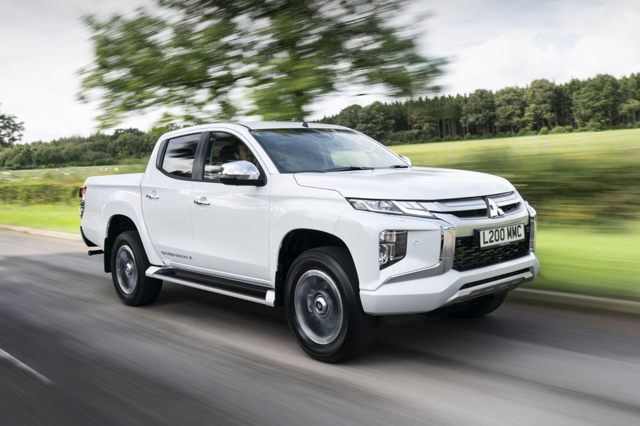
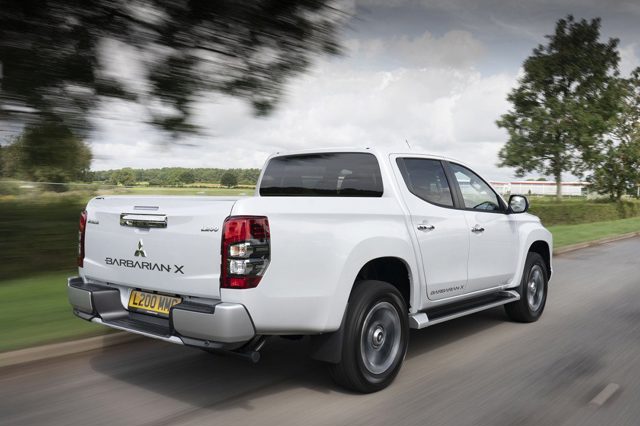
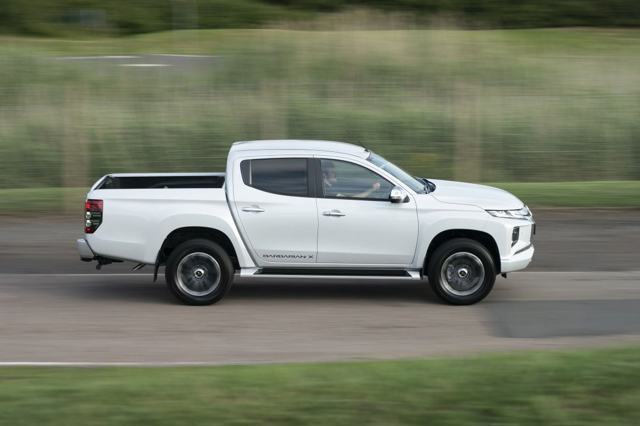
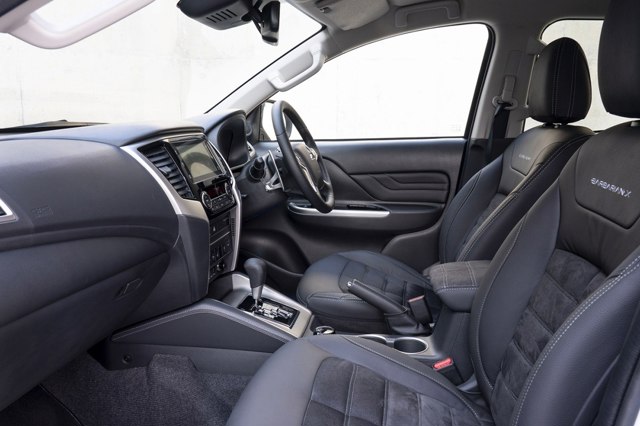
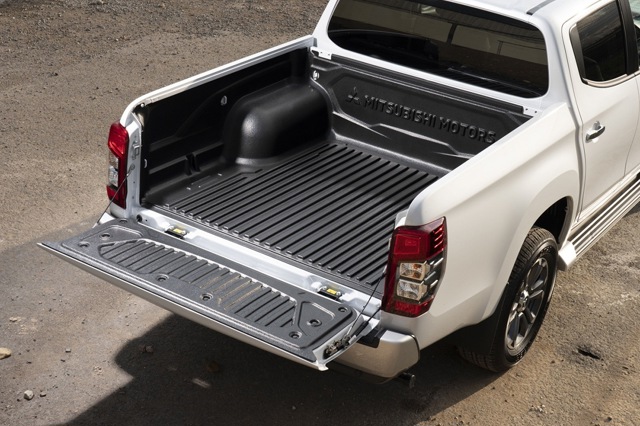

:no_upscale():format(webp)/https://cdn.uk.prod.group-mobility-trader.com/images/cas/c88867f31ef35d1d5ce726aaf575fe82/16c6df25f459f64a3166518bf1a3e317.jpg)

 Much improved on-road handling, still brilliant off-road, well-equipped as standard, five-year-warranty.
Much improved on-road handling, still brilliant off-road, well-equipped as standard, five-year-warranty.
 Key rivals have more power, harsh ride quality at urban speeds, cabin is starting to feel dated.
Key rivals have more power, harsh ride quality at urban speeds, cabin is starting to feel dated.
:no_upscale():format(webp)/https://cdn.uk.prod.group-mobility-trader.com/images/cas/c88867f31ef35d1d5ce726aaf575fe82/16c6df25f459f64a3166518bf1a3e317.jpg)
:no_upscale():format(webp)/https://cdn.uk.prod.group-mobility-trader.com/images/cas/bf8e69ddf29f774f30ff15b4f24c9c6e/6cde9da59d5f97e72b05c29e2a3772d5.jpg)
:no_upscale():format(webp)/https://cdn.uk.prod.group-mobility-trader.com/images/cas/eb315767618d9746e0013f90cbf30dc1/c9c3ceca4d2da4448b5ba6019739288d.jpg)